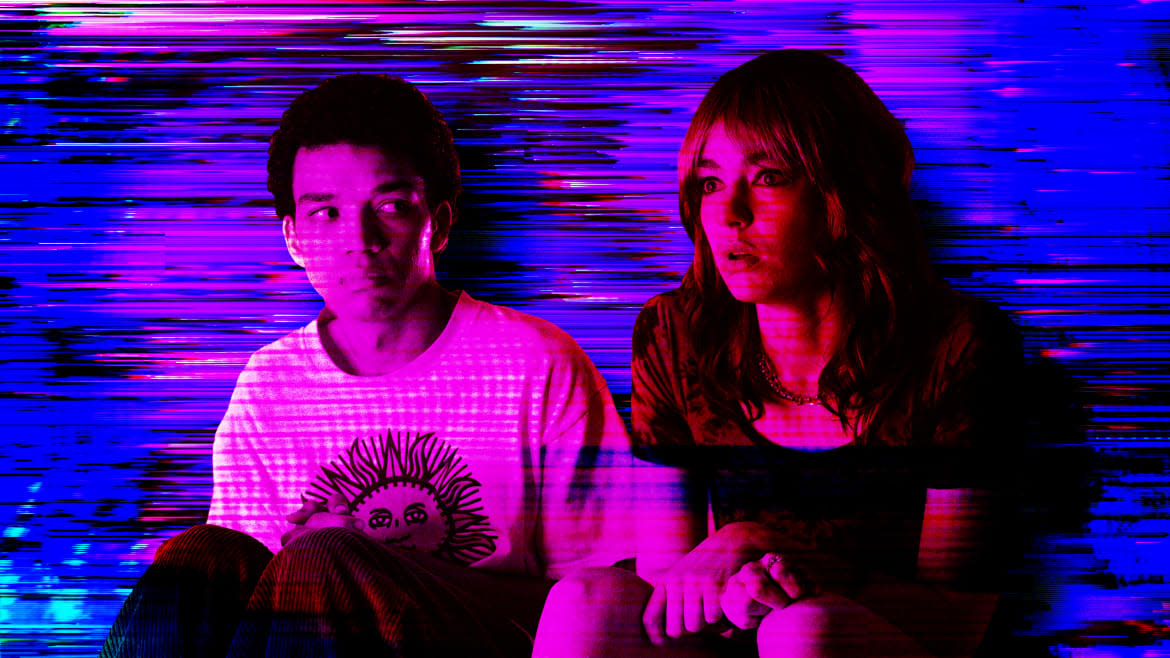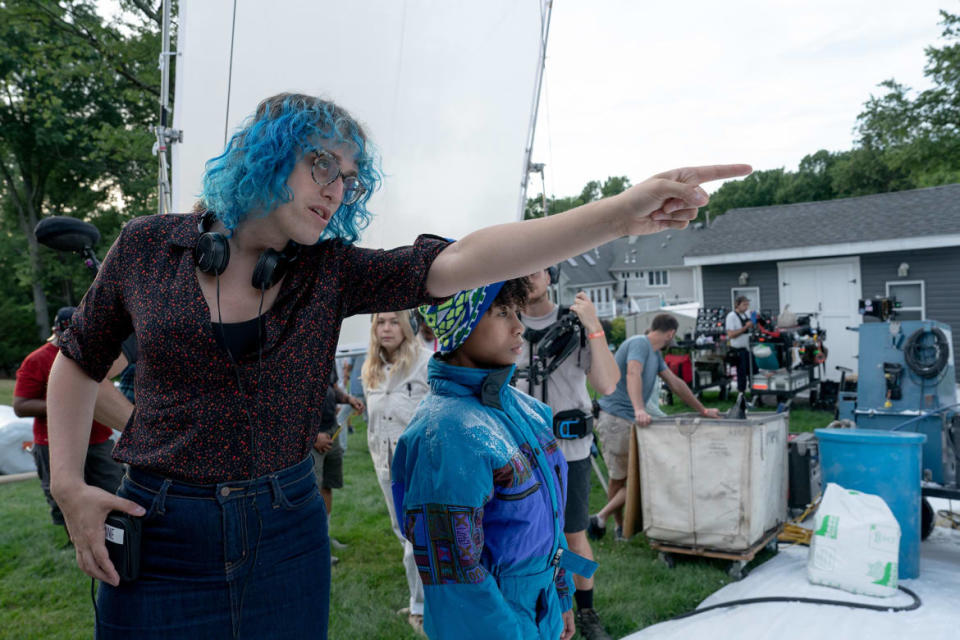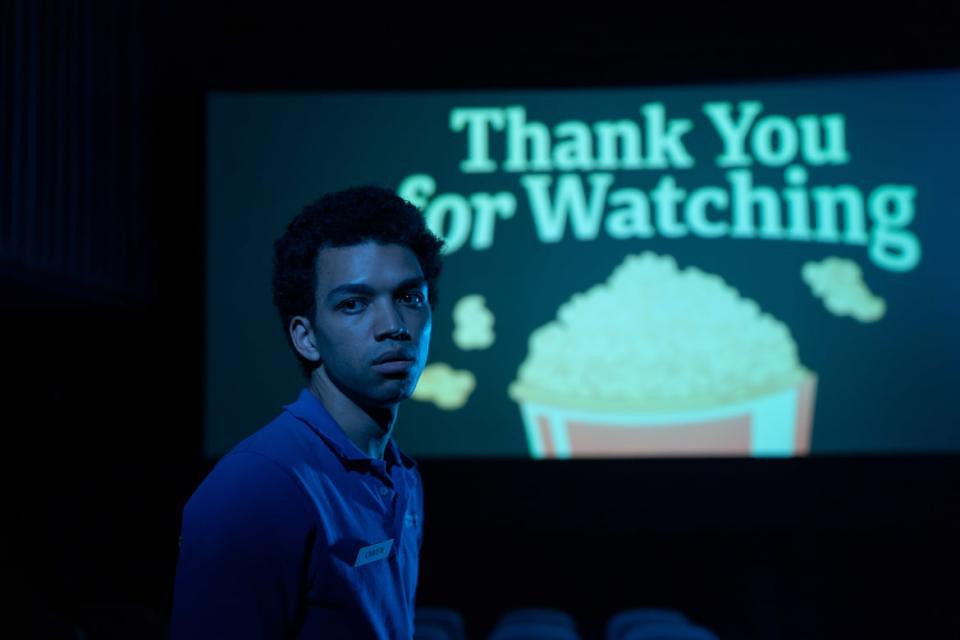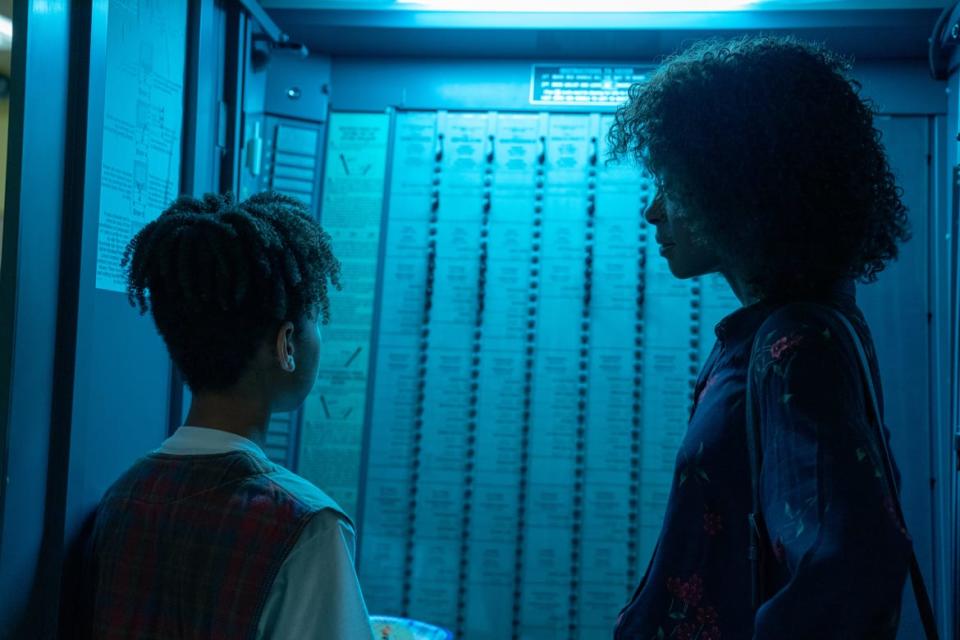‘I Saw the TV Glow’: Meet the Director of the Coolest Movie of the Year

I Saw the TV Glow is one of those movies that seems to crawl under your skin. For months after watching the film, you might just catch yourself thinking a lot about the all-consuming relationship you formed with some TV show as a kid. Your silent moments might be haunted by the memory of Justice Smith’s character, Owen, desperately wheezing. And on a lighter note, the catchy soundtrack will almost certainly lurk in your ears just as often.
There’s a longing quality to director Jane Schoenbrun’s second feature—a forlorn feeling that aches like a lost childhood. Our main characters, Owen and Maddy (Brigette Lundy-Paine) are two teens who build their lives around a kids’ horror TV show. (Naturally, Maddy insists that the show-within-a movie, The Pink Opaque, is way too mature for kids; its lore is too complicated and its monsters are far too scary.) The teens find solace in their favorite show, which grants its protagonists Tara and Isabel far more agency than the real-life teens have ever enjoyed.
While Tara and Isabel live with power and purpose, Maddy and Owen spend most of their time avoiding abuse and mistreatment from their less-than-stellar patriarchs. It’s no wonder the teens would rather watch the show than engage with the realities of their daily lives. Speaking with The Daily Beast’s Obsessed, however, director Schoenbrun, who is nonbinary and uses they/them pronouns, emphasized that Maddy and Owen’s TV obsession has little to do with the show itself.
“When young Owen and Maddy watch The Pink Opaque and love this thing so much, it’s not so much about the actual thing that they're watching, right?” Schoenbrun said. “In fact, by the end of the movie, that almost becomes this red herring of, like, ‘Oh, the thing that you thought was this beautiful, incredible thing was actually not not so special at all in itself.’”

Jane Schoenbrun on set
Instead, it’s the emotion that The Pink Opaque brings out of Owen and Maddy that captivates them. Schoenbrun describes that feeling as love. “When we feel this impulse towards nostalgia, I think often we're trying to recapture that first love,” Schoenbrun said, “or an idea of beauty that feels out of access in our current, present tense.”
To say that I Saw the TV Glow’s relationship with nostalgia is complicated would be a massive, neon-hued understatement. You start to realize that around halfway through the film, when Maddy rips Owen’s world apart during a terrifying conversation at a club called The Double Lunch. Let’s just say that these kids’ relationship with The Pink Opaque was never quite what it seemed.
We spoke with Schoenbrun to unpack the film’s true understanding of nostalgia, its psyche-shattering musical numbers, and how Snail Mail’s Lindsey Jordan wound up playing one-half of The Pink Opaque’s dynamic duo. The following interview has been lightly edited for length and clarity.
Sundance: ‘I Saw the TV Glow’ Is a Haunting Neon Masterpiece
Tell me a little bit about what your relationship with nostalgia is like, and how it shaped the movie’s relationship with nostalgia.
I think I’m a little bit suspicious of nostalgia. It feels like there’s something inherently conservative about nostalgia, right? It’s sort of based in this idea of a return to an imagined innocence or perfection. I have suspicion whenever I find myself feeling that—that what’s actually going on underneath there is maybe not the healthiest of impulses.
At the same time, I’m reading Proust right now. So it’s hard for me not to think about Proust and the madeleine, and this sort of being alive as a human being in the present tense and feeling so gripped by sensations that bring you back to not so much the reality of what existed in the past, but perhaps these traces of feeling. I think a lot of the film is actually about this.
I think there’s also a political dimension to nostalgia. I’m a fan of the theorist Mark Fisher and he talks a lot about this concept of hauntology, which is almost like the dark side of nostalgia, where it’s not so much like longing for the past but feeling haunted by the past—haunted by the media of one’s youth.
Fisher’s theory, which is like an explicitly Marxist one, is all about the fact that the future, as a concept in our late-capitalist moment, has sort of been indefinitely put on hold. Like, we don’t really have a future to invest in or to look forward to. So we find ourselves returning to the nostalgia of the 1980s, or the 1950s, or the 1990s, even. In doing so, we’re confronting this limitation about our current landscape. And this seems kind of right to me. I think that the movie is engaged with this question of hauntology and the end of history.
‘Evil Does Not Exist’: A Japanese Master Returns With Another Cinematic Triumph
The movie perfectly illustrates this feeling I remember having so intensely as a young person—constantly thinking about the life we’re supposed to be having or what things are supposed to feel like. In Owen’s case, gender identity drives that feeling a layer deeper. What did you want to say about those experiences and how they manifest in our relationship with television?
A lot of the stuff that I was thinking about at the earliest stage of this movie was the ways in which my memory of my own childhood has been so influenced by the reflections from television shows about suburban childhood. I grew up in the suburbs, watching these shows that were mythologizing the suburban experience as something that, like, there were monsters lurking in the margins, and there was magic that could be found—relationships that could be deep.
So much of my youth was expecting that for myself and coming up disappointed. But then, I’d also turn to those TV shows to show me this white mirror, I guess—an idealized view of what a suburban upbringing that actually felt magical could look like. I was thankful to them for the glimmer of something that felt magical, but I also felt sort of misled or trapped by a lot of that iconography of the suburbs as a place that could be beautiful, when in my actual reality, it was a pretty stifling place.
Gender identity then intersects with all of this, and queerness in general intersects with all of this. I think I needed those glimmers of magic from the screen a little bit more than people who fit more comfortably into the quote-unquote “real world” of the suburbs. I wasn't getting magic from my upbringing in the way that somebody who maybe is growing up in the right body and identity is. And so I kind of needed to find that fix in another place that was not my own real life.

Justice Smith
Music also obviously plays such an integral role in building out this movie’s themes. I wondered what kind of experience you wanted to create with the sultry musical performance from Sloppy Jane with Phoebe Bridgers and then that intense set from King Woman.
I kind of view those two as this nexus point of the first half of the movie becoming the second half of the movie. In my structural planning for the film, there is a very distinct tone shift that happens somewhere around that moment, where the movie sort of pulls this nostalgic, candy-colored, romantic childhood carpet out from under you and just starts descending into hell.
That scene at the Double Lunch and these two performances that are bookending it felt like a great way to ease people into that transition—narratively, obviously, and in terms of the style of filmmaking, sound design. There’s so many different ways that something shifts at that moment in the film—entering that club through the warmth of the Sloppy Jane and Phoebe Bridgers song, and really feeling the romanticism of that, then shortly thereafter, giving way to this unletting. This both cathartic but almost primal scream.
We’re on our journey downwards toward these characters facing something that is brutal in the way that that [King Woman] performance is brutal.
Blue vomit plays a major role in this movie, and it’s also a big motif for Sloppy Jane. Is that a coincidence? What does blue vomit mean to you?
I think that was kind of kismet. Although, I do also have a blue vomit fixation. When Haley [Dahl, Sloppy Jane frontwoman] told me about her blue vomit fixation, I was kind of into it. You know, it's funny, because the one episode of Are You Afraid of the Dark that really scared me was this one called “The Tale of the Ghastly Grinner,” which is about this evil comic book jester monster figure who comes out of the comic book. And what he does is he laughs in your face until you puke up blue vomit.
I actually don’t remember that one. I’ll have to go back and look for it.
There’s like a unique disquiet to blue vomit. I think it’s even in my first film in We're All Going to the World's Fair. A kid digs these like carnival tickets out of his arm, and there’s kind of blue goop pouring out along with it.
… Yeah, I could do some Freudian work on this, probably.

Ian Foreman and Danielle Deadwyler
And how did Lindsey Jordan of Snail Mail end up playing Tara in The Pink Opaque?
That was a suggestion from my casting director, and I was really into it because I loved Lindsey’s music and had seen her play live a few times. I was like, “Oh, yeah, a badass, queer rock star, kind of teen icon? That makes sense for this character in the show.” And then I met Lindsey and we immediately bonded because she had a tattoo of the Man of the Moon from the Smashing Pumpkins “Tonight, Tonight ”music video, which is obviously like, what Mr. Melancholy is riffing on a bit.
I think I was just kind of like, “That’s kismet, and also, you’re awesome.” And also like, exactly the kind of like, queer-coded and icon that kids would have been obsessed with in the ’90s.
I've met a lot of like, people through my work, and every now and again, I'll meet someone where I'm just like, “Oh, yeah, we would have been friends in college.” And Lindsey is just like, a total chiller. We really get along well, and yeah, I just feel like she’s really a real one—and that comes across in her energy, in her music and her art.
Get the Daily Beast's biggest scoops and scandals delivered right to your inbox. Sign up now.
Stay informed and gain unlimited access to the Daily Beast's unmatched reporting. Subscribe now.

 Yahoo Movies
Yahoo Movies 
